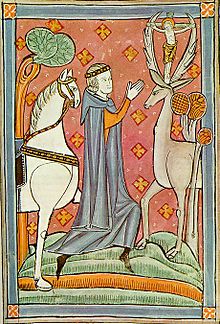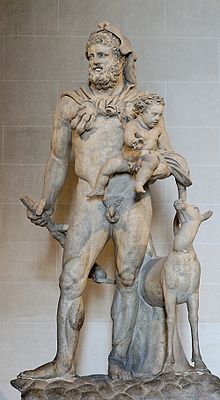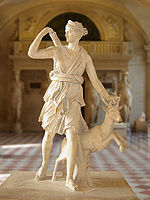- Deer in mythology
-
Deer have significant roles in the mythology of various peoples.
Contents
Celtic
The Insular Celts held deer as supernatural animals, "fairy cattle" that were herded and milked by a localised and benevolent fairy giantess (a bean sìdhe) in each district, who could shift shape to that of a red deer;[1] in the West Highlands, she selected the individual deer that would be slain in the next day's hunt.[2]
In Ireland, An Chailleach Bhéarach, "The Old Woman of Beare", an island off the coast of County Cork, takes the form of a deer to avoid capture; to Beare come characters from the Land of the Dead to visit Ireland.[3] Other Celtic mythological figures such as Oisin, Flidais and Sadb were given connections to deer.
Cernunnos was a god in Celtic mythology that possessed two deer antlers on the top of his head. He was known as The Horned One or The Horned God despite having antlers and not horns. Cernunnos is also known as The Stag Lord, The Horned God of the Hunt, The Lord of the Forest, The Lord of the Hunt, and The Lord of the Animals.[4] However, it is impossible to know exactly because there is no one particular myth concerning him.[5]
Christianity
Saint Giles, a Catholic saint especially revered in the south of France, is reported to have lived for many years as a hermit in the forest near Nîmes, where in the greatest solitude he spent many years, his sole companion being a deer, or hind, who in some stories sustained him on her milk. In art, he is often depicted together with that hind.
In the founding legend of Le Puy-en-Velay, where a Christian church replaced a healing a megalithic dolmen. A local tradition had rededicated the curative virtue of the sacred site to Mary, who cured ailments by contact with the standing stone. When the founding bishop Vosy climbed the hill, he found that it was snow-covered in July; in the snowfall the tracks of a deer round the dolmen outlined the foundations of the future church.
 St Hubertus / St Eustace in a 13th century English manuscript (Biblioteca Marciana)
St Hubertus / St Eustace in a 13th century English manuscript (Biblioteca Marciana)
Saint Hubertus (or "Hubert") is a Christian saint, the patron saint of hunters, mathematicians, opticians and metalworkers, and used to be invoked to cure rabies. The legend of concerned an apparition of a stag with the crucifix between its horns, effecting the worldly and aristocratic Hubert's conversion to a saintly life.
In the story of Saint Hubertus, on Good Friday morning, when the faithful were crowding the churches, Hubertus sallied forth to the chase. As he was pursuing a magnificent stag the animal turned and, as the pious legend narrates, he was astounded at perceiving a crucifix standing between its antlers, which occasioned the change of heart that led him to a saintly life. The story of the hart appears first in one of the later legendary hagiographies (Bibliotheca hagiographica Latina, nos. 3994-4002) and has been appropriated from the earelier legend of Saint Eustace or Placidus.
The deer is considered by some Christians to be a symbol of Christ. The Bible book, Song of Solomon, chapter 2, verses 8-10 reads:
- The voice of my beloved! behold, he cometh leaping upon the mountains,
- skipping upon the hills.
- My beloved is like a roe or a young hart: behold, he standeth behind our wall,
- he looketh forth at the windows, shewing himself through the lattice.
- My beloved spake, and said unto me, Rise up, my love, my fair one, and come away. (KJV)
Many Christians interpret the Song of Solomon to represent the longing of Christ for his Church, and vice versa.
Islam
Ottoman Empire
Turkic peoples that converted to Islam brought with them from the Eurasian Steppe their beliefs and cults involving horns, deer, antlers, hides, etc. (Not entirely without precedent: The pre-islamic Kaaba itself had ram’s horns mounted on its walls). In the Ottoman Empire, and more specifically in western Asia Minor and Thrace the deer cult seems to have been widespread and much alive, no doubt as a result of the meeting and mixing of Turkic with local traditions. A famous case is the 13th century holy man Geyiklü Baba, ‘Father Deer’, who lived with his deer in the mountain forests of Bursa and gave hind’s milk to a colleague (compare with Saint Giles). Material in the Ottoman sources is not scarce but it is rather dispersed and very brief, denying us a clear picture of the rites involved.[6]
Germanic
An Anglo-Saxon royal scepter found at the Sutton Hoo burial site in England features a depiction of an upright, antlered stag. In the Old English language poem Beowulf, much of the first portion of the story focuses on events surrounding a great mead hall called Heorot, meaning "Hall of the Hart".
In the Poetic Edda poem Grímnismál the four stags of Yggdrasil are described as feeding on the world tree, Yggdrasil and the poem further relates that the stag Eikþyrnir lives on top of Valhalla. In the Prose Edda book Gylfaginning, the god Freyr is having once killed Beli with an antler. In Þiðrekssaga, Sigurd is presented as having been nursed by a doe.
Andy Orchard proposes a connection between the hart Eikþyrnir atop Valhalla, the hart imagery associated with Heorot, and the Sutton Hoo scepter.[7] Sam Newton identifies both the Sutton Hoo whetstone and the hall Heorot as early English symbols of kingship.[8] Rudolf Simek says that "it is not completely clear what role the stag played in Germanic religion" and theorizes that "the stag cult probably stood in some sort of connexion to Odin's endowment of the dignity of kings."[9]
Greek
 Heracles, Telephus and the doe (Louvre Museum)
Heracles, Telephus and the doe (Louvre Museum)
In Greek mythology, the deer is particularly associated with Artemis in her role as virginal huntress. Actaeon, after witnessing the nude figure of Artemis bathing in a pool, was transformed by Artemis into a stag that his own hounds tore to pieces. Callimachus, in his archly knowledgeable "Hymn III to Artemis", mentions the deer that drew the chariot of Artemis:
- in golden armor and belt, you yoked a golden chariot, bridled deer in gold.
One of the Labors of Heracles was to capture the Cerynian Hind sacred to Artemis and deliver it briefly to his patron, then rededicate it to Artemis. As a hind bearing antlers was unknown in Greece, the story suggests a reindeer, which, unlike other deer, can be harnessed and whose females bear antlers. The myth relates to Hyperborea, a northern land that would be a natural habitat for reindeer. Heracles' son Telephus was exposed as an infant on the slopes of Tegea but nurtured by a doe.
Hinduism
In Hindu mythology, the goddess Saraswati takes the form of a red deer called Rohit according to the Aitareya Upanishad. Saraswati is the goddess of learning so learned men use deer skin as clothing and mats to sit upon. A golden deer plays an important role in the epic Ramayana. While in exile in the forest, Rama's wife Sita sees a golden deer and asks Rama and Lakshmana to get it for her. The deer is actually a rakshasa called Maricha in disguise. Maricha takes this form to lure Rama and Lakshmana away from Sita so his nephew Ravana can kidnap her.
Hittite
The stag was revered alongside the bull at Alaca Höyük and continued in the Hittite mythology as the protective deity whose name is recorded as dKAL. Other Hittite gods were often depicted standing on the backs of stags.
Judaism
The Tribe Naftali bore a Stag on its tribal banner, and was poetically described as a Hind in the Blessing of Jacob.
In Jewish mythology - as discussed in the Talmud (חולין נט ע"ב) - exists a giant kind of stag by the name "Keresh". He is said to live in a mythical forest called "Divei Ilai".
Occultism
The spirit Furfur in The Goetia is depicted as a hart or winged hart.
Scythian
The Scythians had some reverence for the stag, which is one of the most common motifs in their artwork, especially at funeral sites. The swift animal was believed to speed the spirits of the dead on their way, which perhaps explains the curious antlered headdresses found on horses buried at Pazyryk (illustrated, to the right).
Slavic
In Slavic fairytales, Golden-horned deer is a large deer with golden antlers.
Huichol
For the Huichol people of Mexico,[10] the "magical deer" represents both the power of maize to sustain the body and of the peyote cactus to feed and enlighten the spirit. Animals such as the eagle, jaguar, serpent and deer are of great importance to the Mexican indigenous cultures. For each group, however, one of these animals is of special significance and confers some of its qualities to the tribe.
For the Huichol it is the deer that holds this intimate role. The character of the Huichol tends to be light, flexible and humorous. They have avoided open warfare, neither fighting against the Spanish nor Mexican governments, but holding to their own traditions. The Huichol hunt and sacrifice deer in their ceremonies. They make offerings to the Deer of the Maize to care for their crops, and to the Deer of the Peyote to bring them spiritual guidance and artistic inspiration.
Shinto
Deer are considered messengers to the gods in Shinto, especially Kasuga Shrine in Nara Prefecture where a white deer had arrived from Kashima Shrine as its divine messenger. It has become a symbol of the city of Nara.
Hungarian
In Hungarian mythology, Hunor and Magor, the founders of the Magyar peoples, followed a white stag. The stag lead them into a brand new land that they named Scythia. Hunor and Magor populated Scythia with their descendants the Huns and the Magyars. To this day, an important emblem in Hungary is a many-antlered stag with its head turned back over its shoulder.[11]
Manufactured mythology
Quintus Sertorius, while a general in Lusitania, had a tame white stag which he had raised nearly from birth. Playing on the superstitions of the local tribes, he told them that it had been given to him by the goddess Diana; by attributing all his intelligence reports to the animal, he convinced the locals that it had the gift of prophecy. (See Plutarch's life of Sertorius and Pliny the Elder's chapter on stags (N.H., VIII.50)
The naming of the ship, the "Golden Hind", of Sir Francis Drake is sometimes given a mythological origin, though Drake actually renamed his flagship, in mid-voyage, 1577, as a gesture to flatter his patron Sir Christopher Hatton, whose armorial bearings included the crest "a hind Or." In heraldry, a "hind" is a doe.
Notes
- ^ J. G. McKay, "The Deer-Cult and the Deer-Goddess Cult of the Ancient Caledonians"Folklore 43.2 (June 1932), pp. 144-174; McKay (p. 149) points out that the usual term for a giantess, ban-fhuamhair, a cannibal ogress, is never app lied to the "Old Woman[disambiguation needed
 ]"
]" - ^ J.F. Campbell of Isalay, Popular Tales of the West Highlands, ii, no. 27, noted by McKay 1932:150.
- ^ "The Chase of Ben Gulbin" (McKay1932:151).
- ^ "Cernunnos the Stag Lor d". Lugodoc. http://www.lugodoc.demon.co.uk/CERNUNOS.HTM.
- ^ Matthews, John and Caitlin (2005). The Element Encyclopedia of Mythical Creatures. HarperElement. pp. 97–98.
- ^ Laban Kaptein, Eindtijd en Antichrist, p. 32ff. Leiden 1997. ISBN 9073782902; Laban Kaptein (ed.), Ahmed Bican Yazıcıoğlu, Dürr-i Meknûn. Kritische Edition mit Kommentar, §§ 7.53; 14.136–14.140. Asch 2007. ISBN 9789090214085
- ^ Orchard (1997:82 and 92).
- ^ Newton, Sam.The Origins of Beowulf p.31
- ^ Simek (2007:70).
- ^ Barbara G. Myerhoff, "The Deer-Maize-Peyote Symbol Complex among the Huichol Indians of Mexico" Anthropological Quarterly 43.2 (April 1970), pp. 64-78.
- ^ Matthews, John and Caitlin (2005). The Element Encyclopedia of Mythical Creatures. HarperElement. pp. 435.
References
- Orchard, Andy (1997). Dictionary of Norse Myth and Legend. Cassell. ISBN 0-304-34520-2
- Simek, Rudolf (2007) translated by Angela Hall. Dictionary of Northern Mythology. D.S. Brewer ISBN 0859915131
Categories:- Mythological archetypes
- Mythological deer
- The voice of my beloved! behold, he cometh leaping upon the mountains,
Wikimedia Foundation. 2010.



